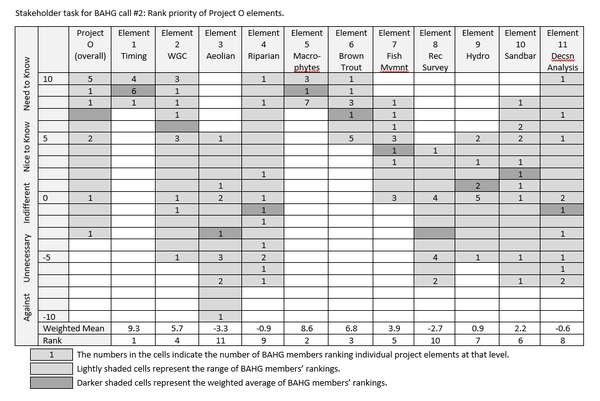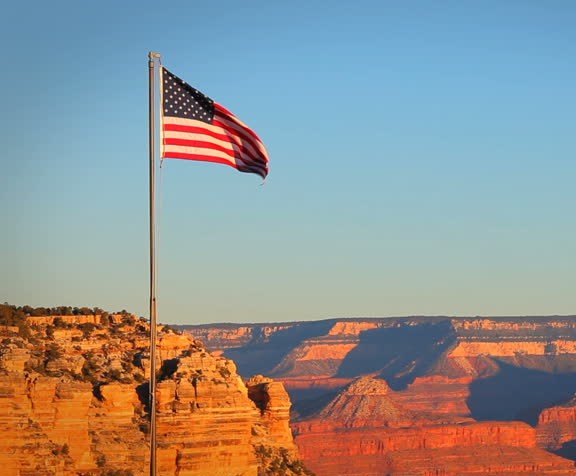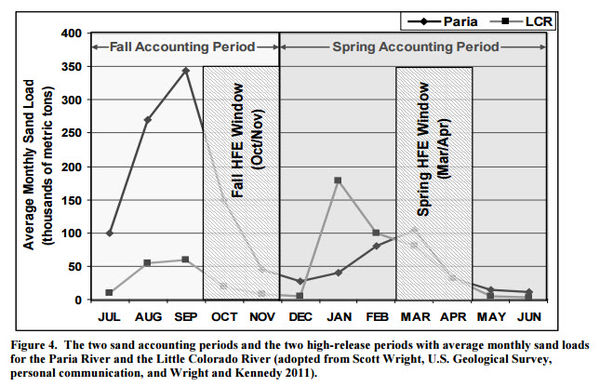May 2019 AMWG Action Item
It was suggested that the TWG take up consideration of the remaining “HFE Assessment” action item, which reads, “A next step would be for GCMRC to identify experimental flow options that would consider high valued resources of concern to the GCDAMP (i.e., recreational beaches, aquatic food base, rainbow trout fishery, hydropower, humpback chub and other native fish, and cultural resource), fill critical data gaps, and reduce scientific uncertainties.” The AMWG did not object to the remaining action item passing from GCMRC to the TWG.
DOI Direction
Dr. Petty Guidance Memo – Page 3 – “In response to stakeholder input at recent AMWG meetings, the feasibility of conducting Spring High Flow Experiments (HFE), along with modeling for improvements and efficiencies that benefit resources including natural, cultural, recreational, and hydropower should be explored. As a potential starting point, I encourage you to consider opportunities to conduct higher spring releases within power plant capacity, along with spring HFEs that may be triggered under the current LTEMP Protocol”
2021-2023 Triennial Budget and Work Plan TWG Motion
The TWG recommends that the AMWG recommend for approval to the Secretary of Interior the Triennial Work Plan and Budget FY 2021-2023 as provided to the TWG on June 23, 2020 and as requested to be revised by the TWG during their meeting on June 23 and 24, 2020.
Revisions requested by the TWG on June 23 and 24, 2020:
- Include the GCMRC B.4 work element in the budget ($58,000 for first 2 years and $64,000 for year 3).
- Remove and/or reduce GCMRC D.2 (approximately $39,000 in year 1, $36,000 in year 2, and $54,000 in year 3) and GCMRC D.3 (approximately $28,000 in year 1, $29,000 in year 2, and $0 in year 3).
- Include Havasu Creek and LCR-mouth gage in GCMRC A.1 at 17,000/year.
- Please change GCMRC Project N verbiage (Pg 294) from “For example, modeling a change in ramp rates to maintain or improve the hydropower and recreational resource objectives is a possible application of GCMRC Project N.” to: “For example, modeling a change in ramp rates to improve the hydropower resource objective is a possible application of Project N.”
- In accordance with direction provided by the AMWG as described in the FLAHG charge, include a project and/or project element to support the FLAHG charge, and provide funding if necessary.
- Remove Reclamation B.4, TWG Chair reimbursement (25,000 for FY 2021)
- Propose AGFD and GCMRC look to integrate work efforts to allow for an additional TRGD site to be monitored. Cost estimate for going from 1 TRGD to 2 TRGD sites is approximately 67,000.
- Prioritize the use of available, unprogrammed and unspent funds from FY 2020, 2021 and 2022 towards funding GCMRC G.6 (JCM-West) in 2023.
August 2020 AMWG budget recommendation
AMWG recommends to the Secretary of the Interior the Glen Canyon Dam Adaptive Management Program Triennial Budget and Work Plan—Fiscal Years 2021-2023 (July 29, 2020 draft), subject to the following:
- Removal from GCMRC Project N the following verbiage:
"Past research into changes in regional energy costs attributed to alteration of GCD operations have shown that no changes occur in hourly prices (U.S. Department of Interior, 2016b). Specifically, hourly energy prices at the regional hub important to GCD (Palo Verde) remain approximately the same with variation in production of energy at GCD. In addition, the analysis of experiments is a short-run analysis, assuming that demand for energy is inelastic (demand does not change with small changes in prices) and surplus power capacity exists. Therefore, changes in $/MW and $/MWh are accurate representations of the changes in consumer and producer surplus when evaluating minor, short-run changes in GCD operations. However, long- run changes in the energy sector may lead to a different economic outcome and a more complete modeling approach would be required. The evaluation of GCD operation and long-run changes in the electricity sector such as the integration of renewable energy, repurposing of federal hydropower resources, or power system capacity expansion would require a significant increase in research scope."
- Consideration of GCMRC Project O is deferred, but will be included in the 2021-2023 Triennial Budget and Work Plan as a proposal to be considered for the Reclamation C.5 Experimental Management Fund, pending revisions to be made by GCMRC and the Bureau of Reclamation and review by the Technical Work Group. After consideration and if recommended by AMWG, a springtime disturbance flow will be planned to occur in coordination with Glen Canyon Dam apron repairs, to ensure sufficient time to integrate the information and learning about the importance of springtime high flows into the 2021-2023 TWP, subject to an evaluation of the resource conditions described in the LTEMP ROD.
- AMWG acknowledges and appreciates the effort to develop Project O in response to elements of the TWG Recommendation for the 2021-2023 Triennial Budget and Work Plan, consistent with guidance from the Secretary’s Designee (memo issued August 14, 2019), and in support of the Flow Ad Hoc Group charge. GCMRC is commended for their effort.
- AMWG members will submit written comments to GCMRC and Reclamation on Project O no later than Friday, September 4, 2020. GCMRC and Reclamation will make revisions based on comments received and will submit the revised Project O plan for TWG consideration by Wednesday, October 7, 2020, for discussion at the October 2020 TWG meeting. AMWG directs the TWG to review the revised Project O and to forward a revised Project O recommendation for AMWG consideration no later than Friday, October 30, 2020. The AMWG will act on the TWG recommendation no later than Friday, November 20, 2020.
BAHG Recommendation (10/08/2020)
The BAHG expresses support for a Project O that evaluates the effects of the proposed FLAHG hydrograph. The BAHG recommends to the TWG the following elements outlined in Project O (July 2020 draft) be prioritized in the following rank order for funding a first year of work effort:
Tier 1 Projects (Weighted mean rankings from BAHG rating exercise: 9.3 and 8.6). The BAHG identified that these project elements are the most important for understanding the effects of the proposed FLAHG hydrograph.
- Project Element O.1. Does Disturbance Timing Affect Food Base Response?
- Project Element O.5. Mapping Aquatic Vegetation Response to a Spring Pulse Flow
Tier 2 Projects (Weighted mean rankings from BAHG rating exercise: 6.8, 5.7, and 3.9). The BAHG identified that these project elements are very important for understanding the effects of the proposed FLAHG hydrograph.
- Project Element O.6. Brown Trout Early Life Stage Response to a Spring Pulse Flow
- Project Element O.2. Bank Erosion, Bed Sedimentation, and Channel Change in Western Grand Canyon
- Project Element O.7. Native Fish Movement in Response to a Spring Pulse Flow
Tier 3 Projects (Weighted mean rankings from BAHG rating exercise: ≤ 0). The BAHG identified that these project elements are important for understanding effects of the proposed FLAHG hydrograph.
- Project Element O.11. Decision Analysis
- Project Element O.4. Riparian Vegetation Physiological Response
- Project Element O.8. Do Disturbance Flows Significantly Impact Recreational Experience?
- Project Element O.3. Aeolian Response to a Spring Pulse Flow
The BAHG acknowledges that the following projects are already funded in the TWP as Projects N.1 and B.1, thus a recommendation on rank priority is unnecessary:
- Project Element O.9. Are There Opportunities to Meet Hydropower and Energy Goals with Spring Disturbance Flows? (funded in N.1).
- Project Element O.10. Sandbar and Campsite Response to Spring Disturbance Flow (funded in B.1).
In our deliberations of Project O, the BAHG recommends that the Experimental Fund (Reclamation C.5) should not be used to support the following items and, to the extent that a proposed project element includes an item, that item should be removed from the project element:
- Multi-year commitments because the decision to use the Experimental Fund is made on a year-by-year basis;
- Monitoring for experiments or activities that occur with a level of regularity or certainty that would lend themselves to be planned for and funded through the TWP because this is counter to the intent of the Experimental Fund; and
- Salaries for positions lasting more than one year (i.e. anything more than a one-year term position or contract) because this may lead to unreasonable expectations of work security.
The BAHG also recommends that prioritizing elements in Project O for funding through the Experimental Fund should be made in context with other requests from the Experimental Fund and vice versa.

October 2020 TWG Flow Ad Hoc Group (FLAHG) Hydrograph Motion
The TWG recommends that the AMWG recommend to the Secretary of the Interior, to implement, when conditions warrant and consistent with the LTEMP protocol for implementing flow experiments, the spring disturbance flow hydrograph developed by the FLAHG in coordination with the GCMRC, as described in the FLAHG Predicted Effects document and associated presentations to the TWG on October 14, 2020.
October 2020 TWG Project O Motion
The TWG recommends that the AMWG recommend to the Secretary of the Interior GCMRC’s “Project O” proposal, as provided to the TWG on October 7, 2020, for inclusion in the 2021-2023 Triennial Budget and Workplan, but with the following revisions and areas of emphasis:
- Reclamation retains decision-making authority for the allocation of funds from the C.5 Experimental Management Fund.
- Requests to support Project O through the Experimental Management Fund should be considered in context with other requests from the Experimental Management Fund (i.e. including, but not limited to Projects A.4, B.6.1-5, and J.3) and vice versa.
- Consideration of funding for Project O elements should be in accordance with the recommendation developed by the BAHG on October 8, 2020.
- Elements O.1 and O.2 – Funding requests for Year 2 should come from TWP carryover funds from prior years or through annual review of the TWP.
- Element O.11 – Funding requests for Year 1 and Year 2 could come from TWP carryover funds from prior years or through annual review of the TWP or other Reclamation considerations.
- References to specific years (e.g. FY2021) will be replaced with general references to Year 1 and Year 2 to accommodate uncertainty regarding implementation timing.
- Opportunities to leverage external resources and support from Program partners will be considered and explored by GCMRC and Reclamation.
November 2020 AMWG Flow Ad Hoc Group (FLAHG) Hydrograph Motion
The AMWG recommends to the Secretary of the Interior, to implement, when conditions warrant and consistent with the LTEMP protocol for implementing flow experiments, the spring disturbance flow hydrograph developed by the FLAHG in coordination with the GCMRC, as described in the FLAHG Predicted Effects document (dated October 6, 2020) and associated presentations to the AMWG on November 17, 2020.
November 2020 AMWG Project O Motion
The AMWG recommends to the Secretary of the Interior GCMRC’s “Project O” proposal, as provided to the AMWG on November 10, 2020, for inclusion in the 2021-2023 Triennial Budget and Workplan, with the following areas of emphasis:
- Reclamation retains decision-making authority for the allocation of funds from the C.5 Experimental Management Fund.
- Requests to support Project O through the Experimental Management Fund should be considered in context with other requests from the Experimental Management Fund (i.e. including, but not limited to Projects A.4, B.6.1-5, andJ.3) and vice versa.
- Consideration of funding for Project O elements should be in accordance with the recommendation developed by the BAHG on October 8, 2020.
- Elements O.1 and O.2 – Funding requests for Year 2 should come from TWP carryover funds from prior years or through annual review of the TWP.
- Element O.11 – Funding requests for Year 1 and Year 2 could come from TWP carryover funds from prior years or through annual review of the TWP or other Reclamation considerations.
- Opportunities to leverage external resources and support from Program partners will be considered and explored by GCMRC and Reclamation.
|





